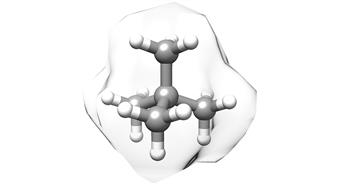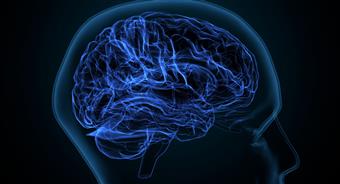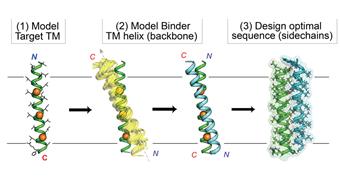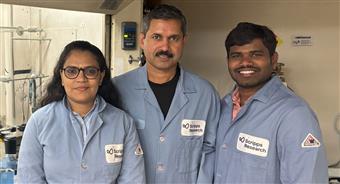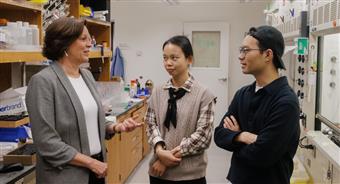
Structure of depression-linked brain receptor solved, offering possible new treatment route Powerful microscopic view of factor involved in major depression and chronic stress offers insights into cell signaling, presenting a possible way to tackle mood disorders.
November 18, 2021
JUPITER, FL Scientists at Scripps Research, Florida have determined the near-atomic-scale structure of an unusual brain-cell receptor called GPR158, which has been linked to depression and anxiety.
The structural study reveals both the receptor and its regulating complex, advancing understanding of basic cell receptor biology. It also enables work on potential therapeutics designed to block GPR158 as a strategy for treating depression, anxiety and possibly other mood disorders.
In the study, published Nov. 18 in the journal Science, the researchers used ultracold, single-particle electron microscopy, or cryo-EM, to map, at a resolution of about a third of a billionth of a meter, the atomic structure of GPR158, both on its own and when bound to a group of proteins that mediate its activity.
We've been studying this receptor for more than 10 years, and have done a lot of biology on it, so it's really gratifying to see for the first time how it's organized, says lead author Kirill Martemyanov, PhD, Professor and Chair of the Department of Neuroscience at the Scripps Research.
Clinical depression, also called major depressive disorder, is estimated to affect roughly 20 million people in the United States in any given year. Current treatments work on other known receptors, including monoamine, but don't always work well for all people and alternative options are needed.
Martemyanov and his team found in a 2018 study that GPR158 is present at unusually high levels in the prefrontal cortex of people diagnosed with major depressive disorder at the time of their death. They also found that exposing mice to chronic stress increased levels of this receptor in the mouse prefrontal cortex, leading to depression-like behavior whereas eliminating GPR158 activity in chronically stressed mice made them resistant to depression and the effects of stress. Additionally, the activity of GPR158 receptor has been also linked to prostate cancer.
Historically, GPR158 hasn't been easy to study. It is called an orphan receptor because scientists haven't yet identified the molecule responsible for turning its signaling function on in a manner similar to flipping a switch. The receptor is also considered unusual because, in the brain, unlike most receptors in its family, it exists in close association with a protein complex called the RGS signaling complex. RGS is short for regulator of G protein signaling and it acts as a powerful brake on cellular signaling. However, it has been unclear why GPR158 engages it.
In the new study, solving the receptor's structure offered many insights into how GPR158 works. First, scientists found that it binds RGS complex in the same way that many receptors typically engage their conventional transducers, leading to the idea that it employs RGS proteins as means of transducing its signal. Second, the structure revealed that the receptor exists as two interconnected copies of the GPR158 proteins stabilized by phospholipids.
These are fat-related molecules that effectively staple the two halves of the receptor together Martemyanov explains.
Finally, on the other side of the receptor that faces outside of the cell, an unusual module called the cache domain was revealed. The authors believe the cache domain serves as a trap for the molecules that activate GPR158. Cache domains have never been observed in these types of receptors before, demonstrating the unique biology of this orphan receptor.
First author Dipak Patil, PhD, a staff scientist in the Martemyanov laboratory, says solving the structure provides many new insights.
I am thrilled to see the structure of this unique GPCR. It is first of its kind, showing many new features and offering a path for drug development, Patil says.
The challenge is now to use the information gleaned from the structure to inform the design of small molecule therapeutics to combat depression, Martemyanov adds.
He is now exploring several possible approaches, including disrupting the two-part arrangement, interfering with engagement of RGS complex, or by specifically targeting the cache domain with small, drug-like molecular binders. Regardless of the road taken, availability of structural information should greatly facilitate drug development efforts to treat depression, Martemyanov says.
This study was made possible by the latest technological advances in microscopy, including freezing proteins at ultra-cold temperatures and examining their organization through the lens of powerful microscopes, a technique called cryogenic electron microscopy, or Cryo-EM.
The microscope uses a beam of electrons instead of light to image protein assemblies. The shorter wavelength of electrons compared to light allowed us to visualize our sample at near-atomic resolution, says structural biologist Professor Tina Izard, PhD.
Patrick Griffin, PhD, Scripps Research, Florida scientific director, co-authored the study, applying a structural proteomic platform technology.
The promise of Cryo-EM for achieving significant breakthroughs in solving structures of biomolecules is enormous. Our Institute is firmly committed to expanding Cryo-EM microscopy, which is made possible through the recent acquisition and installation of a new microscope on campus.
The study was a collaboration including researchers from Columbia University and Appu Singh, PhD, a structural biologist at the Indian Institute of Technology in Kanpur.
In addition to professors Martemyanov, Griffin, Izard and Singh, and Staff Scientist Patil, the authors of the study, Cryo-E
More from Scripps
20/04/2024
New copper-catalyzed C-H activation strategy from Scripps Research Two-mode reactions inspired by human detox enzymes offer powerful new tools for drug discover...
12/04/2024
Scripps Research chemists devise easier new method for making a common type of building block for drugs Scientists transform simple linear amines into saturated...
06/04/2024
A simple, inexpensive way to make carbon atoms bind together A Scripps Research team uncovers a cost-effective method for producing quaternary carbon molecules,...
04/04/2024
Developing a vaccine for the zombie drug xylazine Scripps Research chemical biologists design an early proof-of-concept vaccine that could lead to the first...
30/03/2024
How blocking a neural receptor responsible for addiction could reduce alcohol use A Scripps Research team found that a new therapeutic that targets the kappa op...
13/03/2024
New computational strategy boosts the ability of drug designers to target proteins inside the membrane Customized-design approach could streamline the design of...
29/02/2024
Scripps Research scientists reveal how first cells could have formed on Earth New phospholipid discovery brings researchers closer to understanding how primordi...
29/02/2024
How molecular handedness emerged in early biology Scripps Research chemists fill a major gap in origin-of-life theories.
February 28, 2024
LA JOLLA, CA Mole...
22/02/2024
Snaking toward a universal antivenom Scripps Research scientists discovered antibodies that protect against a host of lethal snake venoms.
February 21, 2024
...
06/02/2024
Calibr-Skaggs announces expansion of option and license agreement with AbbVie to develop novel cell therapies for solid tumors and autoimmune diseases
AbbVie...
26/01/2024
Re-energizing mitochondria to treat Alzheimer's disease Scripps Research team restored neuron-to-neuron connections in human cells.
January 25, 2024
LA JO...
24/01/2024
100 years of Science Changing Life: Scripps Research celebrates a century of transforming human health For the last century, institute leaders and renowned scie...
23/01/2024
New technology lets researchers track brain cells' off switches The method could shed light on what goes awry in numerous brain conditions when neurons ar...
09/01/2024
Three decades of giving: Announcing the Calibr-Skaggs Institute for Innovative Medicines The ALSAM Foundation, founded by the Skaggs family, provides lasting g...
04/01/2024
Life science entrepreneur Gene Lay joins Scripps Research Board of Directors Lay, founder of the global biotech company BioLegend, brings invaluable experience ...
21/12/2023
Taming a plant-derived toxin Scripps Research team modifies the traditional poison picrotoxinin for potential neurological drugs and anti-parasite treatments. ...
19/12/2023
Scripps Research Executive Vice President Eric Topol gives TED talk on transformative power of AI in medicine Topol provides an overview of how AI models can i...
13/12/2023
New AI-powered algorithm could better assess people's risk of common heart condition Early detection of atrial fibrillation can reduce the risk of stroke an...
07/12/2023
Nanoparticle flu vaccine design shows promise in early tests Scripps Research-designed vaccine could provide broad, enduring protection against influenza A str...
16/11/2023
Numerous Scripps Research scientists named Highly Cited Researchers Clarivate's annual, global list represents researchers who have demonstrated significant...
07/11/2023
Multiple sclerosis drug invented at Scripps Research slows long-term devastating disease progression Late-breaking data reinforces the effectiveness and safety ...
05/10/2023
Keren Lasker named a 2023 Moore Inventor Fellow The prestigious award will support Lasker's inventive research in membraneless organelles and their applica...
22/09/2023
Michael Bollong named a 2023 Amgen Young Investigator The prestigious award will support Bollong's research identifying new molecular targets and therapeuti...
09/09/2023
Philip Dawson receives 2024 American Chemical Society National Award Dawson is honored with the Arthur C. Cope Late Careers Scholar Award for his foundational c...
07/09/2023
Scripps Research chemists devise a method for C-H activation of alcohols The method represents a new toolkit for making drugs and other compounds.
September 06...
31/08/2023
Scripps Research receives $1.5M to surveil infectious disease threats in wastewater Bill & Melinda Gates Foundation award to support the development of multi-pa...
16/08/2023
How cold temperatures trigger the brain to boost appetite Scripps Research scientists' discovery could lead to new weight loss and metabolic health treatmen...
08/08/2023
Human antibody that targets carfentanil, fentanyl and related opioids reverses overdose effects in preclinical study Scripps Research-developed antibody therapy...
04/08/2023
How sensory neurons impact the gut Scripps Research scientists show that the receptor PIEZO2 in sensory neurons controls gut motility and transit time, which a...
26/07/2023
AbbVie and Calibr Expand Strategic Collaboration to Advance Several Preclinical and Early-stage Clinical Assets The expanded strategic collaboration will advan...
23/07/2023
Scripps Research scientists develop AI-based tracking and early-warning system for viral pandemics Machine-learning system effectively predicts emergence of pro...
19/07/2023
Monitoring T cells may allow prevention of type 1 diabetes Scripps Research study shows that analyzing T cells in blood samples could be used to select at-risk ...
19/07/2023
Scripps Research mourns passing of leading organic chemist Albert Eschenmoser Eschenmoser pioneered key reactions in synthetic chemistry and shaped the understa...
15/06/2023
Scripps Research awarded $46.8 million by NIH to promote human health through innovative translational science and training The Translational Institute is harne...
13/06/2023
Scripps Research's Danielle Grotjahn named 2023 Pew Scholar in the Biomedical Sciences The award will support Grotjahn's study of how cells assemble the...
31/05/2023
Crossing the ring: new method enables C-H activation across saturated carbocycles Scripps Research chemists add another powerful tool to their molecular editin...
24/05/2023
Scripps Research develops behind-the-scenes tool for better biomedical data discovery The new resource makes datasets more discoverable for life science communi...
19/05/2023
Scripps Research neuroscientist Hollis Cline elected to American Academy of Arts and Sciences Cline is recognized for her discoveries about the role of sensory ...
19/05/2023
Scripps Research's Skaggs Graduate School awards doctoral degrees to 31st graduating class Commencement ceremony will be livestreamed via Zoom and on instit...
13/05/2023
A better route to benzocyclobutenes, sought-after building blocks for drugs Scripps Research chemists devise a new, C-H activation-based method for the synthesi...
09/05/2023
Renowned Scripps Research professor Jeffery Kelly elected to National Academy of Sciences Kelly's groundbreaking work on protein misfolding has led to thera...
28/04/2023
Mirror-image molecules pave new path for cancer drug discovery By comparing how mirror image versions of small molecules impact clusters of proteins, Scripps R...
22/04/2023
How alcohol consumption contributes to chronic pain A Scripps Research team showed how both alcohol intake and alcohol withdrawal can lead to increased pain and...
21/04/2023
Xin Jin receives dual awards to study autism risk genes in neurodevelopment Major grants from the National Institutes of Health and California Institute for Reg...
20/04/2023
Trim the sugar: New HIV vaccine design improves immune response Scripps Research vaccine candidate headed for clinical trials.
April 19, 2023
LA JOLLA, CA A...
18/04/2023
Therapeutic can seek and destroy potent opioid to treat overdoses Scripps Research chemists developed a new biologic to work against the synthetic opioid carfen...
07/03/2023
How heavy alcohol consumption increases brain inflammation The findings by a Scripps Research team point toward a potential new drug target for treating alcohol...
02/03/2023
Scientists find human antibodies that can block multiple coronaviruses including SARS-CoV-2 Results from a Scripps Research and UNC team pave the way for a vacc...
28/02/2023
$10 million grant funds Scripps Research Alcohol Research Center through its 50th year The five-year grant supports research into the neurobiology of alcohol us...
28/02/2023
Immune system drug shows promise in treating alcohol use disorder, a Scripps Research clinical trial reports Scientists at Scripps Research found that apremilas...
 Structure of depression-linked brain receptor solved, offering possible new treatment route Powerful microscopic view of factor involved in major depression and chronic stress offers insights into cell signaling, presenting a possible way to tackle mood disorders.
Structure of depression-linked brain receptor solved, offering possible new treatment route Powerful microscopic view of factor involved in major depression and chronic stress offers insights into cell signaling, presenting a possible way to tackle mood disorders.















